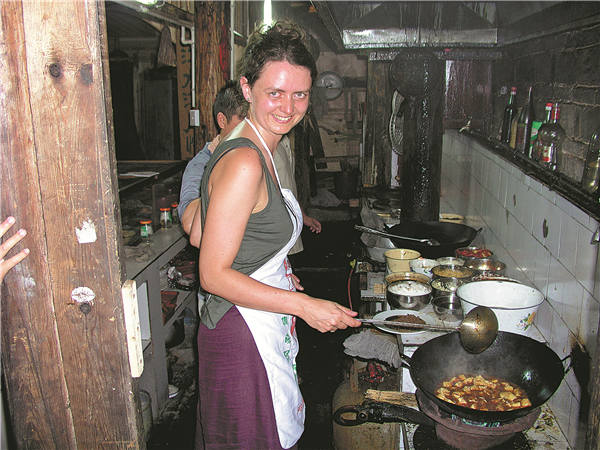
British author Fuchsia Dunlop cooks Mapo tofu, stir-fried tofu in hot sauce, in the kitchen of a restaurant in Fenghuang ancient town in western Hunan province.
Gourmet chef's books show how to serve up the best of Chinese cuisine, Yang Yang reports.
British gourmet Fuchsia Dunlop's posts on social media networks, WeChat or Instagram, are fun to read. You could say they serve up a diet of humor. Most of the posts are about her experience with food from around the world. But since the COVID-19 pandemic broke out in London last February, she has posted more about her cooking, especially Chinese dishes she made in her kitchen.
Now she has become a cook that's better at Chinese dishes than European ones, and cooking has become a way for her to cope with the "endless lockdown". She says she cooks in a very relaxed way, going to the farmers' market at the weekend to buy seasonal products for everyday cooking-a mixture of Jiangnan (the region south of the Yangtze River), Hunan, Guangdong, and Sichuan dishes.
"For me, there are so many wonderful things about Chinese food. The thing that I find is greatest about it is that you can eat food that is both really delicious and incredibly healthy," Dunlop says. "The Chinese are experts at cooking vegetables, so it's very comfortable, easy and natural for me to eat Chinese food a lot. Almost every day."
Growing up in a household in Oxford always filled with exotic flavors from Japan, Turkey, Spain, India and Austria, Dunlop dreamed of becoming a cook when she was little. However, her dream did not start to materialize until she came to Chengdu, capital of Sichuan province, as a university student in 1994. That was when she began learning local cooking skills at the Sichuan Higher Institute of Cuisine, while looking for delicious food in the city and nearby areas.

A photo published in the Chinese edition of Land of Fish and Riceby British author Fuchsia Dunlop: a farmer picking gorgon fruit from the water in Jiangsu.
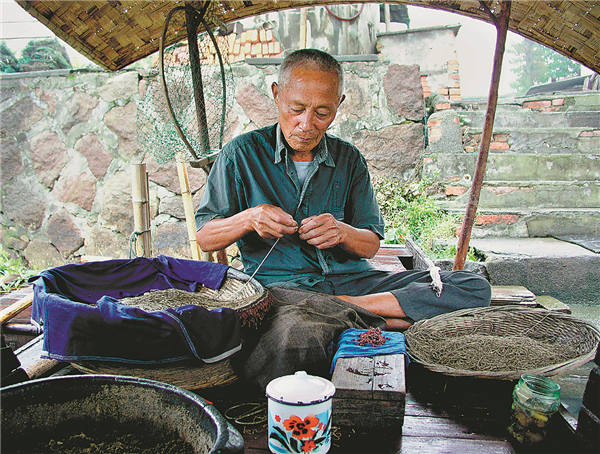
A photo published in the Chinese edition of Land of Fish and Riceby British author Fuchsia Dunlop: a fisherman in Jiangsu province working on his boat.
Always keeping a notebook on hand wherever she went, she wrote down the recipes of the dishes she tasted. Based on her knowledge of Sichuan cuisine, Dunlop published her first book, Sichuan Cookery, in 2001, which was hailed by the Observer Food Monthly as "one of the top 10 cookbooks of all time".
Since then, she has published four books about Sichuan cuisine. She has also written one on recipes from Hunan province, and Land of Fish and Rice in 2016 about recipes from Jiangnan, which includes Shanghai, and provinces of Zhejiang, Jiangsu and southern Anhui-the region that is "blessed with a warm and nurturing climate, fertile land, and lakes, rivers and coastal waters that teem with fish and seafood".
Now a Chinese version of Land of Fish and Rice translated by He Yujia is available. In the book, Dunlop displays her profound understanding of the food culture that runs deep in the blood of Chinese culture.
"Food is a representation of culture anywhere in general, but in China it has a particular importance," she says. "China is a place where food has been culturally important since the beginning, not only socially, but also in sacrifice and ritual, so food is a way into understanding and appreciating China and its culture in general."
Having studied Chinese food culture for nearly two decades, she regards the Jiangnan region as the heartland of the nation's gastronomy.
"Although you have really interesting and delicious food all over China, in this region, particularly, people wrote about it and discussed it. Many of the old classic food books came from this region, for example. So if you talk about gastronomy, and not just about good food, then Jiangnan is a really important region," she says.
Since 2006 when she visited Yangzhou of Jiangsu province for the first time, Dunlop had spent 10 years researching the book.
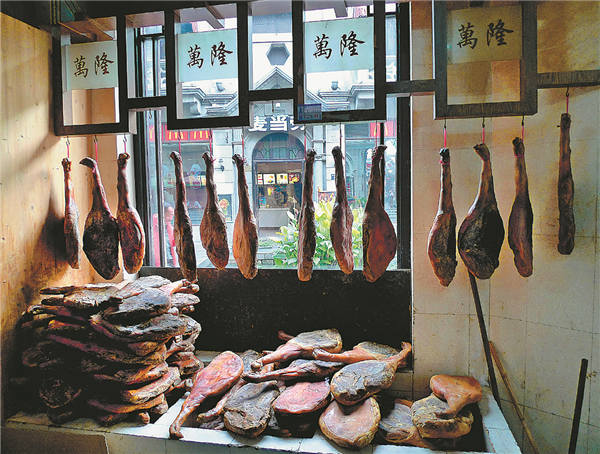
A photo published in the Chinese edition of Land of Fish and Rice by British author Fuchsia Dunlop: Jinhua ham for sale at a store in Hangzhou, Zhejiang province.
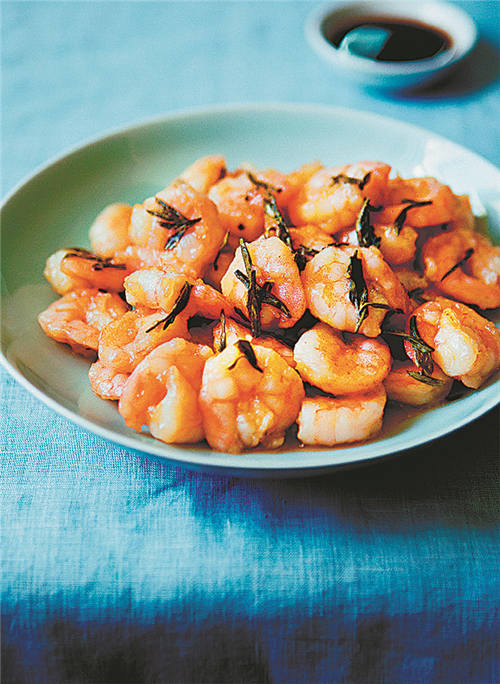
Dishes inside include stir-fried shrimp with Dragon Well tea leaves.
The decisive moment was in 2008 when she went to Longjing Caotang, or the Dragon Well Manor, a restaurant in Hangzhou, Zhejiang province, where the whole approach to ingredients, seasoning, cooking and tradition was so moving and impressive that, at that moment, she decided to write a book about the region, she says.
By then, she had published three books about Sichuan and Hunan cuisine, both of which are famous for being stimulatingly spicy. But in Hangzhou and Yangzhou, she encountered food that was calm, peaceful, soothing and delicate.
To better understand the context of the food in Jiangnan, Dunlop started reading Chinese classics like The Dream of the Red Chamber which contained detailed descriptions of dishes eaten by literati and aristocratic families in ancient China. Her love for food also drove her to museums to see artifacts related to the history of food, and also mansions and gardens in Jiangsu's Suzhou and Yangzhou.
"Jiangnan food is connected with Chinese literature. Lots of dishes have quite literary names or stories behind them," she says.
As a result, when introducing food in the book, besides tracing the history of the dishes, she also tells stories like how Su Dongpo, a great poet during the Song Dynasty (960-1279), invented Dongpo Pork in the 11th century, or quotes his poem that praises delicious sea bass.
The countryside was another destination for her to get a sense of the landscape, atmosphere, culture and people of the region.
"When I write a cookbook, I don't want to just rush in, collect material and write a cookbook. I want to feel a sense of connection with the place and make friends there to have a real affection for it, and that takes time. You can't do that instantly."
After collecting all the recipes, Dunlop tested them at her home in London to make sure they worked for people in the West.
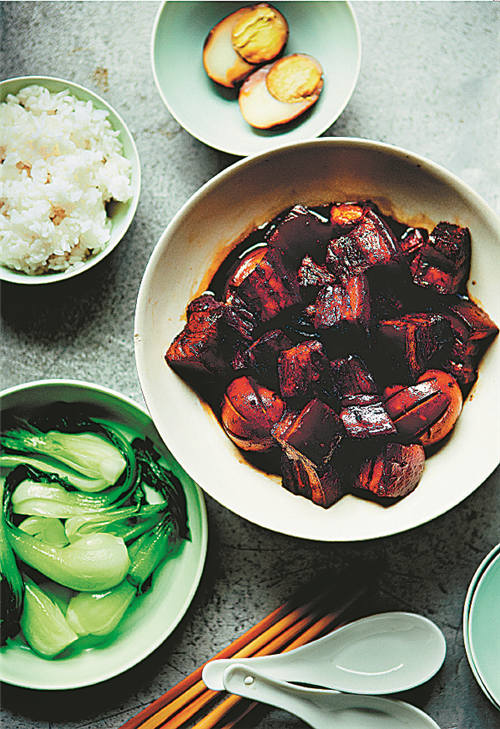
Dishes inside include Shanghai red-braised pork with eggs.
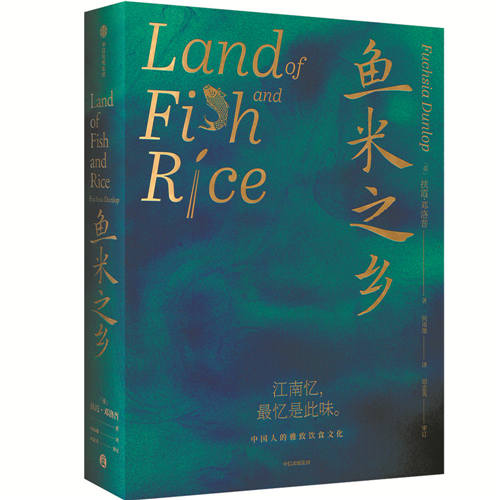
Cover of the book's Chinese edition.
"What I want to do is to try, to the best of my ability, to describe the recipes accurately. If I make a change, I explain it," she says.
The 350-page book is divided mainly into three parts: the introduction of Jiangnan and its regional food culture, the recipes-including appetizers, meat, poultry and eggs, fish and seafood, tofu, vegetables, soups, rice, noodles, dumplings, snacks, sweet desserts and drinks-and concluding with a summary of basic recipes, ingredients, equipment and techniques for making Jiangnan cuisine.
In total, there are more than 160 recipes that cover the typical food and dishes that people in Jiangnan will eat, either at a sumptuous banquet or at home every day, such as clear-simmered lion's head meatballs, eight-treasure stuffed calabash duck, Hangzhou breakfast tofu, "green pak choy with dried shrimps" or "green soybeans with snow vegetable".
However, because Jiangnan is a large region, it was not easy for her to decide which dishes should be presented in the limited number of pages.
"In the end, it's just a matter of personal choice and judgment," she says, adding that she wanted to include as many as possible of the really essential famous dishes like Dongpo Pork, Westlake vinegar fish, and lion-head meatballs, "the really classic dishes".
"But I also like to include dishes that I've enjoyed, or that have a particular meaning for me, like maybe a simple dish that someone cooked for me that I thought was lovely and that I want to cook at home.
"It's like trying to paint a picture of the region and show its many different sides, the different dishes from Ningbo, Shaoxing, and Hangzhou, different regional dishes and different levels of dishes, from the banquet to the street food," she says.

